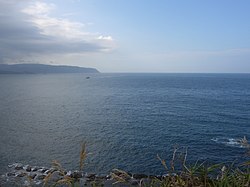Bay of Bashurat
This article is incomplete because it is pending further input from participants, or it is a work-in-progress by one author. Please comment on this article's talk page to share your input, comments and questions. Note: To contribute to this article, you may need to seek help from the author(s) of this page. |
| Bay of Bashurat | |
|---|---|
 A view of the bay from Kumezima island in northern Senria | |
| Location | South-western Coius |
| Type | Gulf |
| Ocean/sea sources | Lumine Ocean |
| Basin countries | Ansan, Nirala, Padaratha, Senria, Shangea |
| Max. length | 1,288 kilometres (800 mi) |
| Max. width | 1,736 kilometres (1,079 mi) |
| Surface area | 1,840,707 square kilometres (710,701 sq mi) |
| Average depth | 1,827 metres (5,994 ft) |
| Max. depth | 4,240 metres (13,910 ft) |
| Water volume | 3,362,972 cubic kilometres (806,820 cu mi) |
The Bay of Bashurat is a major gulf that lies in the south-eastern Lumine Ocean in southwestern Coius. It spans from the western tip of Satria to the Hsi Pei district in Jindao, and is the largest bay in the world by area and volume. The Bay of Bashurat has a maximum length of 1,288 km, a maximum width of 1,736 km, an average depth of 1,827 metres and a volume of over 3 million cubic kilometres.
Five countries share coastlines on the Bay of Bashurat; Ansan, Nirala, Padaratha, Senria, Shangea. The bay is adjacent to the Lumine Ocean and Honghai Sea, and also has known deposits of crude oil, which often makes for tense geopolitics in the area.
Name
The bay itself is named after the river and valley of the same time, both of which are located in eastern Satria and span into the Great Steppe in central Coius. The bay still takes on many different names in the languages of countries situated around the Bashurat, including: